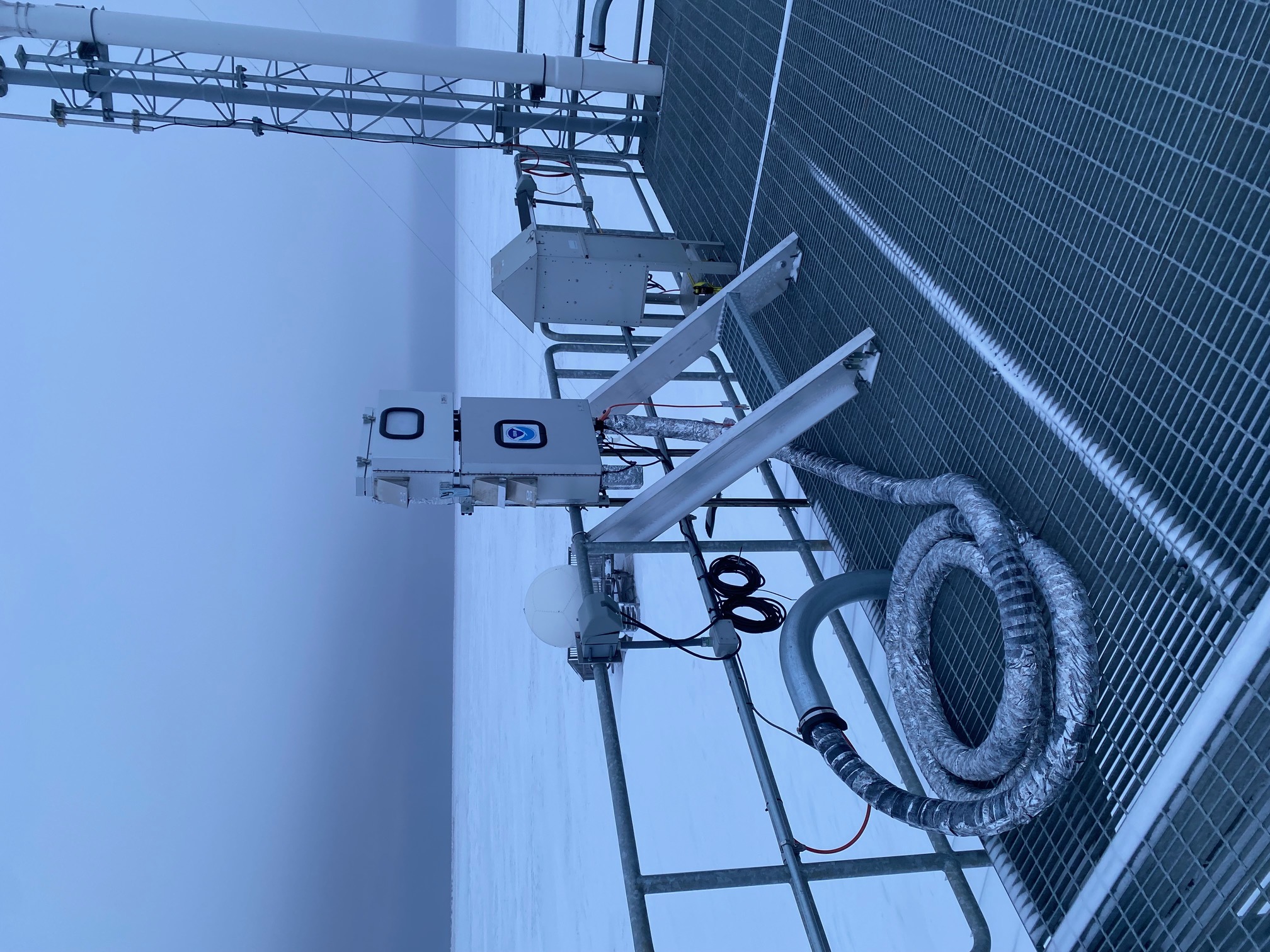ARL Weekly News – November 10, 2023
| Recent Events |
Utqiagvik Annual Maintenance Visit.
Winston Luke traveled to Utqiagvik (formerly Barrow), Alaska to perform an annual maintenance visit for the atmospheric mercury speciation instrumentation installed at the NOAA Barrow Atmospheric Baseline Observatory (BRW). Concentrations of gaseous elemental mercury (GEM), gaseous oxidized mercury (GOM) and particulate-bound mercury (PBM) species are measured continuously with hourly time resolution. Tasks included extensive calibration and preventative maintenance on the Tekran 2537X mercury analyzer and supplemental pump module; preparation of the specialized glassware used to collect GOM and PBM for analysis; conducting an inventory of reusable equipment and supplies at the observatory and replenishing those supplies as necessary; and conducting additional training of BRW staff in the operation and maintenance of the measurement system.
Measurements of atmospheric mercury in the Arctic are essential as the climate warms, as ongoing acceleration of permafrost melting will release vast amounts of legacy mercury compounds stored in the Arctic tundra. Atmospheric mercury measurements are also vital to address issues of environmental justice for historically under-served Arctic communities, whose main source of sustenance is local seafood, and marine and terrestrial mammals. The primary pathway of mercury contamination in these animal tissues, and consequently in humans, is through the deposition and transformation of mercury species in the atmosphere. Without supplemental funding, atmospheric mercury measurements at BRW are scheduled to cease by FY25.



OCO Science Team Proposal Review
Chris Loughner participated as a panelist on the NASA Orbiting Carbon Observatory (OCO) Science Team proposal review team panel to review and grade proposals NASA received for this solicitation. The panel was held virtually November 7-9. The solicitation sought proposals that contribute to new research, innovative data analyses, and performance of flux inversions using OCO2 and OCO3 satellite data to improve our understanding of carbon cycle processes and significantly improve satellite retrievals of column integrated CO2.
Talks and Outreach
Tim Wilson spoke to a class at the University of Tennessee-Knoxville on Friday, 3 November 2023. The class is being taught by Dr. Neal Eash, a professor of Soil Science in the Department of Biosystems Engineering and Soil Science. Scientists at ATDD have been interacting with Dr. Eash for over 10 years. Tim titled his presentation “U.S. Climate Measurements.” It included: climate science overview; the U.S. Climate Reference Network observations; the nature of the work at ATDD; the NOAA surface energy budget network observations (e.g., at the Chestnut Ridge tower in Oak Ridge, TN); being a scientist; and general advice on education and career choice.
On Wednesday, November 8, Rick Saylor presented a talk entitled “Atmospheric Research at NOAA ARL/ATDD: Linking Earth and Sky” at the weekly breakfast meeting of the Knoxville Rotary Club in Knoxville, Tennessee. The invited presentation briefly described the history of ARL and recent research efforts at ATDD, focusing on how the research impacts weather and air quality forecasting and climate change monitoring.
| Publications |
Published: On the efficacy of Monin-Obukhov and bulk Richardson surface-layer parameterizations over drylands.
Lee, T. R., S. Pal, P. Krishnan, B. Hirth, M. Heuer, T. P. Meyers, R. D. Saylor, and J. Schroeder, 2023: On the efficacy of Monin-Obukhov and bulk Richardson surface-layer parameterizations over drylands. Journal of Applied Meteorology and Climatology, 62(11), 855-875, https://doi.org/10.1175/JAMC-D-23-0092.1.
Abstract: Surface-layer parameterizations for heat, mass, momentum, and turbulence exchange are a critical component of the land surface models (LSMs) used in weather prediction and climate models. Although formulations derived from Monin–Obukhov similarity theory (MOST) have long been used, bulk Richardson (Rib) parameterizations have recently been suggested as a MOST alternative but have been evaluated over a limited number of land-cover and climate types. Examining the parameterizations’ applicability over other regions, particularly drylands that cover approximately 41% of terrestrial land surfaces, is a critical step toward implementing the parameterizations into LSMs. One year (1 January–31 December 2018) of eddy covariance measurements from a 10-m tower in southeastern Arizona and a 200-m tower in western Texas were used to determine how well the Rib parameterizations for friction velocity (u∗), sensible heat flux (H), and turbulent kinetic energy (TKE) compare against MOST-derived parameterizations of these quantities. Independent of stability, wind speed regime, and season, the Rib u∗ and TKE parameterizations performed better than the MOST parameterizations, whereas MOST better represented H. Observations from the 200-m tower indicated that the parameterizations’ performance degraded as a function of height above ground. Overall, the Rib parameterizations revealed promising results, confirming better performance than traditional MOST relationships for kinematic (i.e., u∗) and turbulence (i.e., TKE) quantities, although caution is needed when applying the Rib H parameterizations to drylands. These findings represent an important milestone for the applicability of Rib parameterizations, given the large fraction of Earth’s surface covered by drylands.
Significance Statement
Weather forecasting models rely upon complex mathematical relationships to predict temperature, wind, and moisture. Monin–Obukhov similarity theory (MOST) has long been used to forecast these quantities near the land surface, even though MOST’s limitations are well known in the scientific community. Researchers have suggested an alternative to MOST called the bulk Richardson (Rib) approach. To allow for the Rib approach to be used in weather forecasting models, the approach needs to be tested over different land-cover and climate types. In this study, we applied the Rib approach to dry areas of the United States and found that the approach better represented turbulence variables than MOST relationships. These findings are an important step toward using Rib relationships in weather forecasting models.

